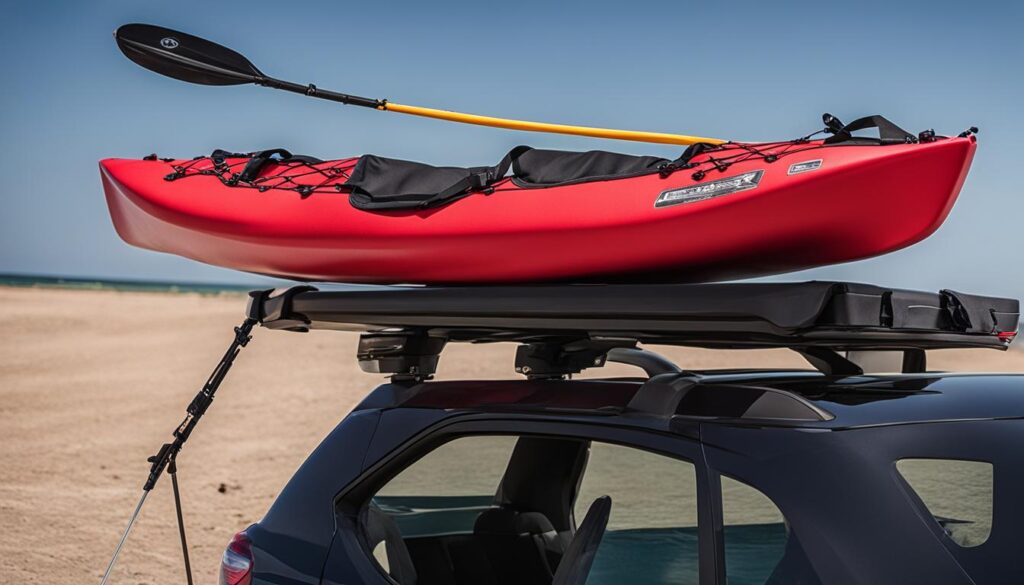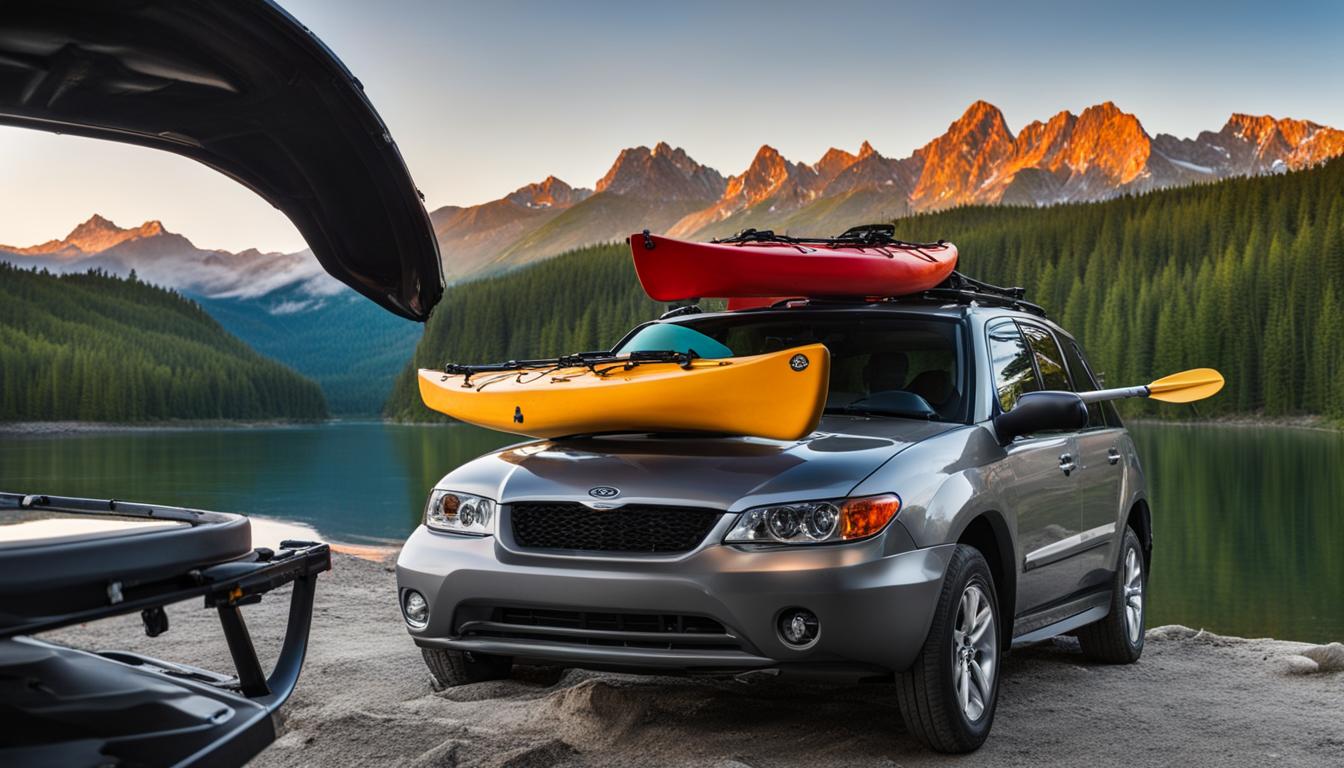When it comes to transporting your kayak, ensuring its safety and protection is of utmost importance. You want to make sure that your beloved vessel arrives at its destination unscathed and ready for your next adventure. In this article, we will provide you with valuable tips and tricks on how to protect your kayak during transportation, from kayak transport covers to kayak tie-down covers. So, let’s dive in and learn how to safeguard your kayak while on the move.
Key Takeaways:
- Invest in a protective kayak cover or bag to shield your kayak from external elements during transport.
- Use foam blocks or padding solutions to cushion and secure your kayak on the roof of your car.
- Consider utilizing kayak transport accessories for added security and peace of mind.
- Explore different rack systems, such as cradles or flat bars, to securely tie down your kayak.
- For those without roof racks, protective kayak bags or transport bags can be a viable alternative.
Best Ways to Secure Your Kayak on the Roof of Your Car
When it comes to transporting your kayak on the roof of your car, ensuring a secure tie-down is crucial. By utilizing the best methods and accessories, you can protect your kayak from damage during transportation. Here are some top tips:
1. Foam Blocks:
Use kayak transport foam blocks to provide cushioning and support for your kayak. These blocks fit on your car’s roof rack and help distribute the weight of your kayak evenly. They also prevent any direct contact between the kayak and the rack, minimizing the risk of scratches or hull damage.
2. Protective Kayak Straps:
Invest in high-quality protective kayak straps specifically designed for transport. These straps should be strong, adjustable, and secure, ensuring your kayak stays in place during the journey. Make sure to tighten the straps adequately to prevent any shifting or movement of the kayak.
3. Kayak Transport Protection Accessories:
Consider using additional kayak transport protection accessories for added security and peace of mind. These accessories can include bow and stern tie-downs, which provide extra stability and prevent the kayak from lifting off the roof. It’s also worth investing in a kayak cockpit cover to protect the interior of your kayak from dust, debris, and unwanted critters during transportation.
By following these best practices and using the right equipment, you can confidently secure your kayak on the roof of your car, ensuring it arrives at its destination safely and in top condition.
| Accessory | Description |
|---|---|
| Foam Blocks | Provide cushioning and support for the kayak and prevent direct contact with the roof rack. |
| Protective Kayak Straps | Securely hold the kayak in place and prevent any shifting or movement during transportation. |
| Kayak Cockpit Cover | Protects the interior of the kayak from dust, debris, and unwanted critters. |
Different Types of Rack Systems for Kayak Transportation
When it comes to transporting your kayak, having the right rack system is essential. Different types of rack systems offer various levels of security and padding for your kayak during transportation. In this section, we will explore the different types of rack systems available to help you make an informed choice for your kayaking adventures.
Rack Type 1: Flat Bars
Flat bars are a popular and straightforward option for tying down your kayak. These bars provide a stable surface for securing your kayak and can be attached to the crossbars of your car’s roof rack. To ensure the safety of your kayak, use kayak transport guards to prevent hull deformation and damage.
Rack Type 2: Cradles
Cradles, such as “J bars” and “saddle” or “V” cradles, offer added security and padding for your kayak during transportation. J bars provide a secure and space-saving option by holding your kayak on its side, while saddle or V cradles offer a supportive and cushioned surface for your kayak to rest on. Utilizing kayak transport guards in combination with cradles can further protect your kayak’s hull.
Rack Type 3: Stackers
If you need to transport multiple kayaks, stackers are a great option. These rack systems allow you to stack two or more kayaks on top of each other, maximizing your car’s roof space. Stackers typically come with straps and tie-downs to ensure the stability of your kayaks during transportation. Remember to use kayak transport guards to prevent any potential damage to your kayaks’ hulls.
| Rack System | Features |
|---|---|
| Flat Bars | – Simple and easy to use – Provides a stable surface for tying down your kayak – Use kayak transport guards for added protection against hull deformation |
| Cradles | – Offers added security and padding for your kayak – J bars hold your kayak on its side, saving space – Saddle or V cradles provide a supportive and cushioned surface |
| Stackers | – Great for transporting multiple kayaks – Maximizes roof space by stacking kayaks – Use kayak transport guards to prevent hull damage |
Choose the rack system that best suits your needs and ensure you have the necessary kayak transport guards to protect your kayak during transportation. With the right rack system, you can have peace of mind knowing that your kayak is securely and safely held in place.

Alternative Transportation Methods for Kayaks Without Roof Racks
Not everyone has a car with roof racks to transport their kayak. But don’t worry, there are alternative methods to safely and securely transport your kayak without roof racks. One popular option is to use protective kayak bags or waterproof kayak transport bags.
These bags are specifically designed to securely hold and protect your kayak during transportation. They are made from durable and waterproof materials to ensure that your kayak stays dry and safe from any external elements like rain or dirt. The bags also provide padding and support to prevent any scratches or damage to the kayak hull.
To transport your kayak using these bags, simply place your kayak inside the bag, secure the bag tightly, and then place it inside your car. Make sure to properly secure the bag using straps or tie-downs to prevent it from moving around during transit. It’s also a good idea to use additional padding, such as foam blocks or cushions, to provide extra protection for your kayak.

Benefits of Using Protective Kayak Bags
Using protective kayak bags for transport offers several advantages. First, they provide a convenient and hassle-free way to transport your kayak without the need for roof racks. This is especially useful if you have a smaller car or if you frequently need to transport your kayak inside your vehicle.
Second, these bags offer enhanced protection for your kayak. The durable and waterproof materials shield your kayak from any potential damage caused by rough handling or exposure to the elements. With padded interiors, they prevent scratches and dings, ensuring that your kayak remains in pristine condition.
Lastly, protective kayak bags are versatile and can be used for various types of kayaks, from recreational kayaks to fishing kayaks. They come in different sizes and designs to accommodate different kayak shapes and sizes. This means that regardless of your kayak type, you can find a bag that fits perfectly and provides optimal protection during transport.
So, if you don’t have roof racks but still want to transport your kayak safely and securely, consider investing in a protective kayak bag. It’s a practical and effective alternative that will ensure your kayak arrives at its destination in the best possible condition.
Tips for Tying Down Your Kayak During Transportation
When it comes to transporting your kayak, properly tying it down is crucial for its safety and protection. Follow these tips to ensure a secure and worry-free journey.
1. Utilize Kayak Transport Padding Solutions
One of the key aspects of securing your kayak during transportation is preventing hull deformation. To achieve this, consider using kayak transport padding solutions. These padding options provide an extra layer of protection and help distribute the weight of the kayak evenly, reducing the risk of damage.
2. Use Kayak Tie-Down Covers
In addition to padding, using kayak tie-down covers is another effective way to protect your kayak during transit. These covers shield your kayak from external elements such as dust, dirt, and moisture, keeping it clean and dry throughout the journey. Choose a durable and waterproof cover that fits securely over your kayak.
3. Secure Your Kayak Properly
When tying down your kayak, make sure it is tightly secured to your vehicle. Start by placing foam blocks or padding on your car’s roof rack or crossbars to create a cushioning layer. Then, use high-quality straps or ropes to secure the kayak to the rack, making sure they are tightened securely. Check the stability of your kayak before hitting the road to avoid any mishaps.
Remember, always follow the manufacturer’s recommendations for securing and transporting your specific kayak model. Additionally, regularly inspect your tie-down equipment for any signs of wear or damage to ensure a safe and secure journey with your kayak.
| Tips for Tying Down Your Kayak During Transportation |
|---|
| Utilize Kayak Transport Padding Solutions |
| Use Kayak Tie-Down Covers |
| Secure Your Kayak Properly |
Conclusion
Protecting your kayak during transportation is crucial to keep it safe and intact. By following the tips and tricks mentioned in this article, you can ensure a secure and worry-free kayak transport. Remember to utilize appropriate kayak transport protection methods to safeguard your kayak’s hull during transit.
Whether you’re securing your kayak on the roof of your car or using alternative transportation methods, such as protective kayak bags, always prioritize the safety of your kayak. Proper tie-down techniques, kayak transport padding solutions, and kayak tie-down covers can go a long way in preventing potential damage and hull deformation.
With the right precautions and protective measures, you can enjoy your kayaking adventures without worrying about the safety of your beloved vessel. Take the necessary steps to secure your kayak, whether it’s using foam blocks or cradles, and always remember to protect it from external elements during transportation.
FAQ
How can I protect my kayak during transportation?
To protect your kayak during transportation, use foam blocks for cushioning, secure it tightly with protective kayak straps, and consider using additional kayak transport protection accessories for added security.
What types of rack systems are available for kayak transportation?
There are different types of rack systems available, including flat bars, “J bars,” “saddle” or “V” cradles. Using cradles provides added security and padding for your kayak, while flat bars offer a simple tie-down method.
What can I do if my car doesn’t have roof racks?
If your car doesn’t have roof racks, you can transport your kayak inside your car using protective kayak bags or waterproof kayak transport bags. Ensure the kayak is properly padded and secured to prevent damage during transit.
How should I tie down my kayak during transportation?
When tying down your kayak, make sure to use kayak transport padding solutions to prevent hull deformation. Additionally, use kayak tie-down covers to protect your kayak from external elements during transportation.
Why is it important to protect my kayak during transportation?
Protecting your kayak during transportation is essential to ensure its safety and integrity. By following the tips and tricks mentioned above and utilizing the appropriate kayak transport protection methods, you can transport your kayak with peace of mind and prevent potential damage.





